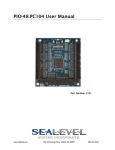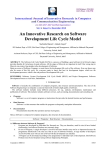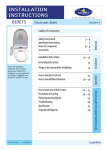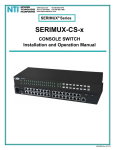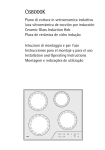Download Electrolux 65300KF-an Cooktop User Manual
Transcript
65300KF-an Ceramic Glass Cooking Surface Operating Instructions/ Installation Instructions l ll lll III II Dear customer, Please read these operating instructions through carefully. Above all, please take note of the «Safety» section on the first few pages. Please keep these operating instructions for later reference. Pass them on to any subsequent owner of the appliance. The warning triangle and/or specific words (Warning!, Caution!, Important!) are used to highlight instructions that are important for your safety or for the function of the appliance. It is imperative that these in structions are observed. 1. This symbol guides you step by step when operating the appliance. 2. ... 3. ... Next to this symbol you receive additional information and practical tips on using the appliance. Tips and information about the economical and ecological use of the ap pliance are marked with a cloverleaf. Before calling out an engineer to a fault please read the chapter «What to do if...» as you may be able to resolve the problem yourself. For further assistence contact your local AEG Service Force Centre, see the chapter Service and Spare Parts". Printed on paper manufactured with environmentally sound processes. He who thinks ecologically acts accordingly ... 2 Content CONTENTS OPERATING INSTRUCTIONS . . . . . . . . . . . . . . . . . . . . . . . . . . . 5 Safety . . . . . . . . . . . . . . . . . . . . . . . . . . . . . . . . . . . . . . . . . . . . . 5 Disposal . . . . . . . . . . . . . . . . . . . . . . . . . . . . . . . . . . . . . . . . . . . 7 Appliance Description . . . . . . . . . . . . . . . . . . . . . . . . . . . . . . . . 8 Control Panel . . . . . . . . . . . . . . . . . . . . . . . . . . . . . . . . . . . . . . . . . . . . Main "On/Off" button . . . . . . . . . . . . . . . . . . . . . . . . . . . . . . . . . . Cooking zone selection . . . . . . . . . . . . . . . . . . . . . . . . . . . . . . . . . "Heat Setting/Residual Heat" display . . . . . . . . . . . . . . . . . . . . . . . Heat setting selection + and - . . . . . . . . . . . . . . . . . . . . . . . . . . . . "Lock" button and indicator . . . . . . . . . . . . . . . . . . . . . . . . . . . . . . Button/Indicators Triple Ring Zone/Casserole Zone . . . . . . . . . . . . "Timer" button and display field . . . . . . . . . . . . . . . . . . . . . . . . . . 9 9 9 9 10 10 10 10 Cooking zone safety switch . . . . . . . . . . . . . . . . . . . . . . . . . . . 11 Prior to Using for the first Time . . . . . . . . . . . . . . . . . . . . . . . 11 Operation of the cooking surface . . . . . . . . . . . . . . . . . . . . . . 12 Tables and Tips . . . . . . . . . . . . . . . . . . . . . . . . . . . . . . . . . . . . . 18 Releasing the safety switch . . . . . . . . . . . . . . . . . . . . . . . . . . . . . . . . . Initial Cleaning . . . . . . . . . . . . . . . . . . . . . . . . . . . . . . . . . . . . . . . . . . . TOUCH CONTROL sensor buttons . . . . . . . . . . . . . . . . . . . . . . . . . . Switching on the appliance . . . . . . . . . . . . . . . . . . . . . . . . . . . . . . Switching off the appliance . . . . . . . . . . . . . . . . . . . . . . . . . . . . . . Cooking with the automatic warm up function . . . . . . . . . . . . . . Cooking without the automatic warm up function . . . . . . . . . . . . Locking/unlocking the control panel . . . . . . . . . . . . . . . . . . . . . . . Switching the triple zone on and off . . . . . . . . . . . . . . . . . . . . . . . Switching the casserole zone on and off . . . . . . . . . . . . . . . . . . . . Setting/changing the cooking time . . . . . . . . . . . . . . . . . . . . . . . . Ending the timer function early . . . . . . . . . . . . . . . . . . . . . . . . . . . Pans . . . . . . . . . . . . . . . . . . . . . . . . . . . . . . . . . . . . . . . . . . . . . . . . . . . Tips on Saving Energy . . . . . . . . . . . . . . . . . . . . . . . . . . . . . . . . . . . . . . Tips for cooking with and without the automatic warm up function . 11 11 12 12 12 13 14 14 15 15 16 17 18 18 19 3 Content Cleaning and care . . . . . . . . . . . . . . . . . . . . . . . . . . . . . . . . . . . 21 What to do if ... . . . . . . . . . . . . . . . . . . . . . . . . . . . . . . . . . . . . 23 INSTALLATION INSTRUCTIONS . . . . . . . . . . . . . . . . . . . . . . . . . 25 Technical Data . . . . . . . . . . . . . . . . . . . . . . . . . . . . . . . . . . . . . . 25 Legal stipulations, standards, directives . . . . . . . . . . . . . . . . . 26 Safety Instructions for the Installer . . . . . . . . . . . . . . . . . . . . 27 Installing into a kitchen worksurface . . . . . . . . . . . . . . . . . . . 28 Electrical connection . . . . . . . . . . . . . . . . . . . . . . . . . . . . . . . . 30 SERVICE & SPARE PARTS . . . . . . . . . . . . . . . . . . . . . . . . . . . . . 31 Ceramic Glass . . . . . . . . . . . . . . . . . . . . . . . . . . . . . . . . . . . . . . . . . . . . The Hob Frame . . . . . . . . . . . . . . . . . . . . . . . . . . . . . . . . . . . . . . . . . . . Remedial action in the case of malfunctions . . . . . . . . . . . . . . . . . . . . 4 21 22 23 Operating Instructions OPERATING INSTRUCTIONS Safety The safety aspects of this appliance comply with the accepted technical standards and the German Appliance Safety Law. However, we also consider it our obligation as a manufacturer to make you aware of the following safety information. Electrical Safety The new appliance may only be installed and connected up by qualified personnel, according to the manufacturers instructions and to the relevant country standards. Repairs to the appliance should only be carried out by approved service engineers. Improper repairs can cause injury or significant malfunction. If your appliance needs repairing, please contact your local AEG Service Force Centre. If your appliance malfunctions, or fractures, cracks or splits appear: - switch off all cooking zones, - Disconnect the hob from the electricity supply. Child Safety The cooking zones will become hot when the hob is in use. Therefore, al ways keep small children away. Safety During Use This appliance is intended for domestic cooking only. It is not designed for commercial or industrial purposes. Do not use the hob to heat the room. Take care when plugging electrical appliances into mains sockets near the hob. Connecting leads must not come into contact with the hot surface. Overheated fats and oils catch fire quickly. You should supervise cooking when preparing foods in fat or oil (e.g. chips). Switch the cooking zones off after use. If a hot pan is placed on a cold cooking zone, and the cooking zone is hea ted by the pan, no indication is given on the residual heat display. 5 Operating Instructions Safety When Cleaning For safety reasons do not clean the appliance with a steam jet or high pres sure cleaner. Clean the hob in accordance with the maintenance and cleaning instruc tions in this manual. How to Avoid Damage to Your Appliance Do not use the hob as a work surface or for storage. Do not use the cooking zones with empty pans, or without pans. Ceramic glass is insensitive to temperature shock and very robust, however it is not unbreakable. Hard and sharp objects, in particular, can damage the cooking surface if they fall on it. Do not use cast iron pans or pans with damaged bases that are rough or burred. Scratching may occur when the pans are slid. Do not place any pans on the hob frame. Scratching may occur or the paint damaged. Ensure that liquids containing acids, e.g. vinegar, lemon or scale remover do not come into contact with the hob frame, otherwise matt spots will ap pear. If sugar or a dish containing sugar comes into contact with a hot cooking zone and then melts, remove the soiling immediately whilst still hot using a scraper. If it cools, damage to the surface may occur on removal. Keep all items and materials that can melt away from the ceramic glass surface, e.g. plastics, aluminium foil, or oven foils. If something of this na ture should melt onto the ceramic glass surface, it must also be removed immediately using the scraper. If you wish to use special types of pan (e.g. a pressure cooker, simmering pan, wok, etc.), please observe the manufacturer's instructions. Avoid boiling pans dry. The bases could be irreparably damaged in the pro cess and the glass ceramic cooking surface also damaged. 6 Operating Instructions Disposal Disposing of the packaging material • All packaging can be recycled, sheet and hard foam parts are appropriately marked. Please dispose of packaging material and any old appliance with due regard to safety and the environment. Information on disposal • The appliance must not be disposed of in the household rubbish. • You can obtain information about collection dates or public tips from your local refuse department or council. Warning! Before disposing of old appliances make them inoperable. Cut off the mains cable. 7 Operating Instructions Appliance Description Features of the hob III II Cooking zone dimensions: rear left: 145 mm rear right: 170/265 mm front left: 210/175/120 mm front right: 145 mm 8 Operating Instructions Control Panel III II Main "On/Off" button For switching on the entire appliance. The appliance is - switched on when the button is touched for approx. one second, - switched off when the button is touched again for one second. When the appliance is switched on the "Heat Setting/Residual Heat" displays are illuminated. Cooking zone selection Buttons for choosing the cooking zone for which the settings are to be changed. The decimal point is illuminated in the display field of the coo king zone just selected. "Heat Setting/Residual Heat" display The four display fields that are assigned to the four cooking zones display: - , after switching on and when automatically switched off by the safety function, to , depending on the heat setting chosen, , when the warm up function is active, , in the case of residual heat, , in the case of a fault. (Decimal point), which cooking zone is active. 9 Operating Instructions Heat setting selection and For setting or changing the heat setting ( to ) for the selected coo king zone, or when in timer mode, for setting or changing the required cooking time. - The heat setting or the cooking time is increased using the button and the automatic warm up function activated. - The heat setting or the cooking time is decreased using the button. "Lock" button and indicator For locking the control panel against accidental setting changes, touch the button for approx. two seconds. The lock is lifted by touching the button again for two seconds. The lock can also be used as a child safety measure. The indicator illuminates when the control panel is locked. Button/Indicators Triple Zone/Casserole Zone For switching on and off the larger cooking zone on the triple cooking zone and the casserole zone. To switch on, the relevant cooking zone must be selected using the cooking zone selection buttons. The indicators illuminate when the outer cooking zone on the triple coo king zone or the casserole zone is switched on. "Timer" button and display field For activating the timer function for the selected cooking zone. The display field shows the cooking time set or remaining for the selected cooking zone. The timer also be used as an "egg timer". Set the desired cooking time. The timer counts the remaining time down back to zero. This function is not assigned to any cooking zone and programming is not possible in this con dition. "Timer Active" Display: the four "Timer Active" indicators show the coo king zones for which the timer is active. Each cooking zone has its own in dicator. It is not possible to use the timer functions "Timer" and "Egg Timer" simul taneously. 10 Operating Instructions Cooking zone safety switch If, after a certain period of time, one of the zones is not switched off or the heat setting not changed, then the cooking zone switches off automati cally. , or is appears in the displays of all the zones that were switched on. The zones are switched off at: • heat setting 1 - 2 after 6 hours • heat setting 3 - 4 after 5 hours • heat setting 5 after 4 hours • heat setting 6 - 9 after 1.5 hours Releasing the safety switch To release the safety switch on all cooking zones switched on, switch the appliance off and on again at the main button. The cooking zones are then ready for use again. appears in the zone display when there is residual heat remaining. Prior to Using for the first Time Initial Cleaning Wipe the ceramic glass cooking surface with a damp cloth to remove any traces left from manufacturing. Important: Do not use any caustic or abrasive cleaners! The surface could be damaged. 11 Operating Instructions Operation of the cooking surface TOUCH CONTROL sensor buttons To operate the TOUCH CONTROL sensor buttons, place your finger flat, from above, on the desired button until the corresponding indicator illuminates, or extinguishes, or the desired function is performed. For quicker adjustment leave your finger on the button until the desired value is reached. All entries are acknowledged by an acoustic signal. Switching on the appliance Switch on the appliance using the main "On/Off" button. The "Heat Setting/Residual Heat" display fields show . After the main "On/Off" button has been operated to switch on your ap pliance, one of the cooking zones must be selected using the cooking zone selection buttons within approx. 10 seconds. Otherwise the appliance swit ches off again for safety reasons. Switching off the appliance Operate the main "On/Off" button to completely switch off the appliance. After the individual cooking zones or the entire cooking surface have been switched off, the presence of residual heat is indicated by (as in "Hot") in the "Heat Setting/Residual Heat" display fields of the respective cooking zones. If all cooking zones are switched off, the appliance switches off automati cally after a period of time. 12 Operating Instructions III II Cooking with the automatic warm up function All four zones have nine heat settings and are equipped with an automatic warm up function. , lowest heat setting , highest heat setting , automatic warm up function. When you select using the -button the cooking setting that you require for cooking once the pan is hot, the cooking zone operates for a certain period of time at full power ( = automatic warm up function) and then switches back to the heat setting selected for further cooking. The duration of the automatic warm up period is dependant on the setting chosen for further cooking once the pan is hot! See page 52. 1. Select the desired cooking zone using the cooking zone buttons. The decimal point in the corresponding display field illuminates. button for the desired cooking setting to . The cooking 2. Press the appears again in dis setting chosen is then displayed. After 5 seconds, play instead of the cooking setting. The cooking setting is displayed again at the end of the automatic warm up time. If you select a higher setting when the automatic function is in operation, e.g. from to , the previous warm up time is taken into account. If you select a lower setting, then the automatic warm up function is brought to an immediate end. If you start cooking again on a cooking zone that is still 13 Operating Instructions warm, the automatic warm up function uses the residual heat. This saves time and energy. Switching off a cooking zone 1. Select the desired cooking zone using the cooking zone buttons. 2. Press the and buttons simultaneously to switch off. Cooking without the automatic warm up function If you want to use the cooking zone in the same way as you are accusto med, that is without the automatic warm up function, then select the desi red heat setting with the -button. Select a high setting for warming up. As soon as steam starts to form or the oil is hot, switch back to the setting necessary for further cooking. 1. Switch on the appliance and select the desired cooking zone using the coo king zone selection buttons. The decimal point in the associated display field illuminates. button, to set the desired cooking setting to . 2. Press the The "Heat Setting/Residual Heat" display field for the corresponding coo king zone indicates the current setting. and buttons, 3. You can adjust the heat setting at any time using the as long as the cooking zone is selected. Switching off a cooking zone 1. Select the desired cooking zone using the cooking zone buttons. 2. Press the and buttons simultaneously to switch off. Locking/unlocking the control panel At any time during the cooking process, the control panel can be locked, with the exception of the "On/Off" button. This means that changes to the settings, e.g. from wiping with a cloth, can be prevented. This function is also useful as a child safety measure. button until the indicator illuminates. 1. Touch the 2. To unlock, touch the lock button again until the indicator extinguishes. Child Safety Measure! If, when the lock button is active, the cooking sur face is completely switched off by touching the main button, when the cooking surface is switched on again, the lock button remains active. This means that the lock button must be operated first, before the zones can be switched on again. 14 Operating Instructions III II Switching the triple zone on and off If a larger cooking zone is required, a larger ring on the triple cooking zone can be switched in. 1. Select the triple cooking zone using the appropriate cooking zone selection button and select the desired heat setting ( to ). 2. Press the triple zone/casserole zone button. The middle ring is switched in. One of the triple cooking zone indicators illuminates. 3. Press the triple zone/casserole zone button again. The outermost zone is switched in. Both triple cooking zone indicators illu minate. 4. To switch off the outer zones, press the triple ring zone/casserole zone but ton again, the triple cooking zone must be selected when this is done. Switching the casserole zone on and off If a larger cooking zone is required, the outer zone on the casserole zone can be switched in. 1. Select the casserole zone using the appropriate cooking zone selection but ton and select the desired heat setting ( to ). 2. Press the triple zone/casserole zone button. The outer zone is switched on. The casserole zone indicator illuminates. 3. To switch off the outer zone, press the triple zone/casserole zone button again, the casserole zone must be selected when this is done. 15 Operating Instructions Setting/changing the cooking time 1. Select the desired cooking zone using the cooking zone selection buttons and set the desired heat setting. 2. Press the "Timer" button to activate the timer function for this cooking zone. or buttons, set or change the amount of time required 3. Using the until the cooking zone is to switch off automatically (e.g. 20 minutes). The timer starts after a few seconds and indicates the amount of time left. The small "Timer Active" indicator is also illuminated for the respective coo king zone, e.g. the upper left indicator corresponds to the rear left cooking zone. At the end of the cooking time set, the cooking zone switches off automa tically and an acoustic signal sounds. 4. Touch the TIMER button to switch off the signal and the indicator. For quicker adjustment, leave your finger on the desired value is reached. or button until the button is operated first, the time setting starts at 99 minutes. If If the the button is operated, the time setting starts at 1 minute. Displaying the remaining cooking time Select the desired cooking zone using the cooking zone buttons. If the selected cooking zone is in timer mode, the remaining cooking time appears in the "Cooking Time" display field. Use of the timer as an interval timer (egg timer) Important! There must be no cooking zones programmed with the timer! 1. Press the "Timer" button to activate the timer function. or buttons (e.g. 20 minutes). 2. Set desired time using the The timer starts after a few seconds and indicates the amount of time left. When the time set is at an end, an acoustic signal sounds. 3. Touch the TIMER button to switch off the signal. 16 Operating Instructions III II Ending the timer function early There are two ways of switching off the timer early: Switching off the cooking zone and timer simultaneously 1. Select the desired cooking zone using the cooking zone buttons. If the selected cooking zone is in timer mode (TIMER indicator illumina ted), the remaining cooking time appears in the timer display field. 2. Touch the switch off. and buttons simultaneously: the cooking zone and timer Switching off the timer - leaving the cooking zone active 1. Select the desired cooking zone using the cooking zone buttons. 2. Touch the "Timer" button again and buttons simultaneously: 3. Touch the - only the timer switches off. - The cooking zone is left on. 17 Operating Instructions Tables and Tips Pans The better the pan, the better the results. • You can recognise good pans by their bases. The base should be thick and as flat as possible. • Pans with aluminium or copper bases can leave metal discoloration on the glass ceramic surface that is very difficult or impossible to remove. • Do not use cast iron pans or pans with damaged bases that are rough or burred. Permanent scratching may occur when the pans are slid. • When cold, pan bases are normally bowed slightly in wards (concave). They should under no circumstances be bowed outwards (convex). Tips on Saving Energy You will save valuable energy if you observe the following tips: • Always place pans on the cooking zone before switching on. • Soiled cooking zones and pan bases increase the electricity consumption. • If possible, always fit pans with a lid. • Switch off the cooking zones before the end of cooking to make use of the residual heat, e.g. to keep food warm or for melting. • The pan base and cooking zone should be the same size. When purchasing pans, pay attention to the diameter of the base. Manufacturers of ten state the diameter of the top of the pan. • Cooking times are reduced by up to 50% when a pressure cooker is used. 18 Operating Instructions Tips for cooking with and without the automatic warm up function The automatic warm up function is suitable for: • dishes that start off cold, are heated up at a high setting and do not need to be continually watched when cooking, • dishes that are put in a hot frying pan. The automatic warm up function is not suitable for: • goulash and similar braised dishes that need continual turning until browned correctly, liquid adding and then braising until cooked, • dumplings, pasta dishes with large amounts of liquid, • cooking with pressure cookers, • very large quantities of soup/stew with more than 2 litres of liquid. General Notes: • When cooking without the automatic warm up function, we recom mend the use of a high heat setting to warm up the food (using the -button) and then leaving the dish to finish cooking at an appro priate lower heat setting. • The heat setting can be used to keep food warm. • Take special note of the results when you use the appliance initially! You can then decide which heat setting is the best for "your dishes" in the "quantities you are accustomed to preparing" with "your pans". You will then rapidly come to value the merits of the automatic function and will feel at ease with your new cooking surface. 19 Operating Instructions The figures given in the following tables are for guidance. Exactly which heat setting needs to be used depends on the quality of the pans and the type and quantity of the food. Table: Cooking and Frying Switch setting Automatic warm up time * (Min.) 9 8 4.5 7 3.5 6 2.5 5 8.5 4 6.5 3 4.8 2 3.0 1 1.0 Cooking process Examples of usage Warm Up Brown Fry Warm up large amounts of liquid, boil pasta, brown meat, (brown goulash, pot-roast) Fry well Steaks, pieces of loin, potato fritters, fried sausages, pancakes Fry cutlets, liver, fish, rissoles, fried eggs Boil Boil up to 1.5 l of liquid, potatoes, vegetables Steam, Sauté Soften Keep warm Melt Steam and sauté small quantities of vegetables, cooking rice and milk based dishes Keep food warm, melt butter, dissolve gelatine, melt chocolate *) when cooking without the automatic warm up function, the warm up time can be selected as required. 20 Operating Instructions Cleaning and care Ceramic Glass Important: Cleaners must not come into contact with the ceramic glass when hot! All cleaners must be removed with plenty of clean water after cleaning as they may have a caustic effect when the rings are next heated! Do not use any aggressive cleaners, such as e.g. grill or oven sprays, coarse scouring cleaners or pan cleaners that cause scratches. Clean the ceramic glass surface after each use when it is hand warm or cold. This means you will avoid soiling becoming burnt on. Remove scale and water marks, fat spots and metallic shimmering discolo ration with a commercially available ceramic glass or stainless steel cleaner, e.g. with "Stahl-Fix or Vitroclen. Light Soilage 1. Wipe the ceramic glass surface with a damp cloth and a little washing up liquid. 2. Then rub dry with a clean cloth. No residues of cleaner must be left on the surface. 3. Once a week, thoroughly clean the entire ceramic glass surface with a com mercially available ceramic glass cleaner such as Vitroclen. 4. Then wipe the ceramic glass surface with plenty of clean water and rub dry with a clean fluff-free cloth. Stubborn Soilage 1. To remove food that has boiled over or burnt on spots, use a glass scraper. 2. Place the glass scraper at an angle to the glass ceramic surface. 3. Remove soiling by sliding the scraper. You can obtain glass scrapers and ceramic glass cleaners from your specialist retailers. 21 Operating Instructions Burnt on Soilage 1. Remove burnt on sugar, melted plastic, aluminium foil or other melted ma terials immediately, while the hob is still hot, using a glass scraper. Important: When using the glass scraper on the hot cooking zone, there is a risk of burns! 2. Clean the cooking surface as normal once it is cold. If the cooking zone has cooled down already prior to the soilage being removed, warm it up again for cleaning. Scratches or dark marks on the ceramic glass surface, which have been caused by a pan base with sharp edges, cannot be removed. However, they do not impair the function of the cooking surface. The Hob Frame Important! Do not put vinegar, lemons or scale removers on the hob frame, otherwise mat spots will appear. 1. Wipe the frame with a damp cloth and a little washing up liquid. 2. Soften dried dirt with a wet cloth. Then wipe off and rub dry. 22 Operating Instructions What to do if ... Remedial action in the case of malfunctions A malfunction may only be caused by a minor fault that you can rectify yourself using the following instructions. Do not perform any other work on the appliance if the following information does not provide assistance in your specific case. Warning: Repairs to the appliance may only be carried out by approved service engineers. Improper repairs can cause injury or serious malfunction. If your appliance needs repairing, please contact your local AEG Service Force Centre. What to do if ... .... the cooking zones do not function? Check whether - the appliance is switched on, - the control lamps are on in the operating field, - the respective cooking zone is switched on, - the cooking zone power level has been set to the desired cooking-on level, - the fuses in the house installation (fusebox) have tripped. If the fuses repeatedly trip, call in an approved electrician. - the safety cut-out of the cooking zones has been tripped. .... the cooking zones cannot be switched on? Check whether - the operating field is locked, - a time period of more than 10 seconds has expired between the opera tion of the On/Off key and switching on the desired cooking zone, - the touch surface is too large (the finger should only be used lightly) - the touch switch has been partly covered by a damp cloth or by a liquid. - the operating field has been touched too soon following a mains failure (to clear the condition, switch the fuse out and then in again). 23 Operating Instructions ... the displays all go out except for the for residual heat? Check whether - the On/Off key has been accidentally operated, - the touch switches are partly covered by a damp cloth, liquid or some thing similar. ... the displays suddenly go out? Check whether - the electricity supply has been temporarily disconnected, or has failed. ... after switching off, no for residual heat is displayed? Check whether - The cooking zone has only been in operation for a short time, and is therefore not hot enough. If the cooking zone is hot, please call in an approved electrician, or call your Local AEG Service Force Centre. .... one of the cooking zones cannot be switched off? Check whether - the touch keys are partly covered by a damp cloth or a liquid. - the corresponding cooking zone key is active, i.e., the decimal point is lit up. .... is shown in the display? Isolate the appliance from the mains immediately and check that the ap pliance has been connected correctly. If you call in an engineer to resolve a problem listed in these notes, or due to an operating error, a charge will be made, even if the appliance is under guarantee. 24 Installation Instructions INSTALLATION INSTRUCTIONS Important! This appliance must be installed by qualified personnel, accor ding to the manufacturer's instructions and to the relevant country stan dards. Technical Data Appliance Dimensions Width Depth Height 605 mm 535 mm 55 mm Cut-Out Dimensions Width Depth Corner radius 560 mm 490 mm R3 Power Consumption Triple cooking zone front left Single cooking zone rear left Casserole zone rear right Single cooking zone front right 800/1600/2300 W 1200 W 1500/2400 W 1200 W Heater Element Voltage 230-240 V ~ 50 Hz Total load Fuse Rating AEG 7.10 kW SC 7.1 kW 30 Amp Prod-nr: 230-240 V, 230-240 V 2 ~50 Hz Typ 230.1EWWBNAPNNA 941 054 493 Serie (Model.no.) 65300KF-an 25 Installation Instructions Legal stipulations, standards, directives This appliance meets the following standards: • EN 60 335-1 and EN 60 335-2-6 in respect of the safety of electrical appliances for household use and similar purposes and • DIN 44546 / 44547 / 44548 in respect of properties of electrical cookers for the household. • EN 55014-2 / VDE 0875 Teil 14-2 • EN 55014 / VDE 0875 Teil 14/12.93 • EN 61000-3-2 / VDE 0838 Teil 2 • EN 61000-3-3 / VDE 0838 Teil 3 in respect of basic electromagnetic compatibility (EMC) requirements. This appliance complies with the following EC directives: • 73/23/EWG dated 19.02.1973 (Low Voltage Directive) • 89/336/EWG dated 03.05.1989 (EMC Directive including Directive Change 92/31/EWG). 26 Installation Instructions Safety Instructions for the Installer • A device must be included in the electrical installation that makes it possi ble to isolate the appliance from the mains supply with a minimum contact separation of 3 mm. Suitable isolation devices are e.g. cut-outs, fuses (remove screw type fuses from the holder), earth leakage trips and circuit breakers. • In respect of fire protection, this appliance corresponds to type Y (EN 60 335-2-6). Only this type of appliance may be installed with a high cupbo ard or wall on one side. • It is not permitted to fit drawers below the cooking surface. • Protection against electric shock must be provided by the installation. • The kitchen unit in which the appliance is fitted must satisfy the require ments of DIN 68930 in respect of stability. • Built-in ovens and cooking surfaces are fitted with special connector sy stems. They may only be combined with appliances with a matching system. • All cut surfaces are to be sealed with a suitable sealant for protection against moisture. • On tiled work surfaces, the joints in the area where the hob sits on the sur face must be completely filled with grout. • On natural, artificial stone, or ceramic tops, the snap action springs must be bonded in place. • Ensure that the seal is correctly seated in the frame and that it is seated against the work surface without leaving any gaps. Additional silicon sea lant must not be applied, this will make removal more difficult in the event of the need for service. 27 Installation Instructions Installing into a kitchen worksurface Make a note of the serial number on the appliance rating plate prior to installation. This number will be required in the case of requests for service and is no longer accessible after installation, as it is on the original rating plate on the underside of the appliance. maximal 100°C optimal 300 mm minimal 50 mm 28 Installation Instructions 5 60 60 = 53 5 0 26 7 0 31 22 3 = R3 22 = 3 26 10 7 3 = min. 30 55 7 Catch spring Screws Worktop Frame Glass ceramic plate 29 Installation Instructions Electrical connection THIS HOB MUST BE EARTHED The manufacturer declines any liability should these safety measures not be observed. The hob is designed to be connected to 230-240V 50Hz AC electrical sup ply. The switch must not break the yellow and green earth cable at any point. Important! Make the electrical connection in accordance with the wiring diagram. • If the mains connection cable has to be replaced, a cable with Spare Parts No. 374 3490 00/0 must be used. After connecting the electrical supply, all cooking zones should be briefly switched on one after the other at their maximum power, in order to test whether they are operational. braun blau grün/gelb = = = brown blue green/yellow brun bleu verte/jaune = = = brown blue green/yellow marrón azul verde/amarillo = = = brown blue green/yellow 374 3217 01 / 5.99 30 Service & Spare Parts SERVICE & SPARE PARTS If you wish to purchase spare parts or require an engineer, contact your local AEG Service Force Centre by telephoning: 08705 929929 Your telephone call will be automatically routed to the Service Centre co vering your post code area. When you contact the Service Centre they will need the following informa tion: 1. Your name & address, including post code. 2. Your telephone number. 3. Clear and concise details of the fault. 4. The model, serial and production number. (This information can be found the rating plate). In order that you have this information to hand when you call, we recommend you write the informa tion below. Product No: ......................................................................... Serial No: ............................................................................. Model No: ............................................................................ 5. Date of purchase. Please note that it will be necessary to provide proof of purchase for any in guarantee service calls. Inguarantee customers should ensure that the chapter headed `Remedying Faults' has been read, as the engineer will make a charge if the fault is not a mechanical or electrical breakdown. Customer Care For general enquiries concerning your AEG appliance or for further infor mation on AEG products please contact our Customer Care Department by letter or telephone as follows: Customer Care Department AEG Domestic Appliances 55-77 High Street Slough Berkshire SL1 1DZ Tel: 08705 350350 31 AEG Hausgeräte GmbH Postfach 1036 D-90327 Nürnberg http://www.aeg.hausgeraete.de Copyright by AEG 374 3557 04 / 02.00 mh 32


































